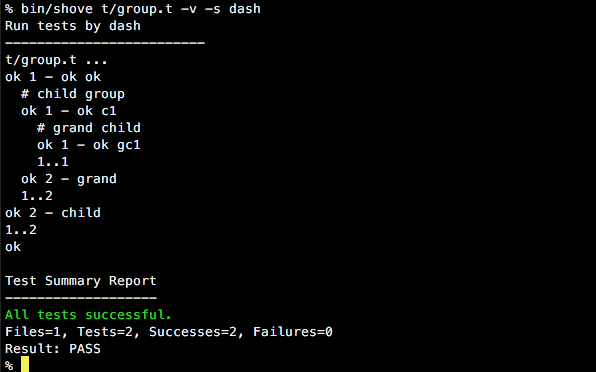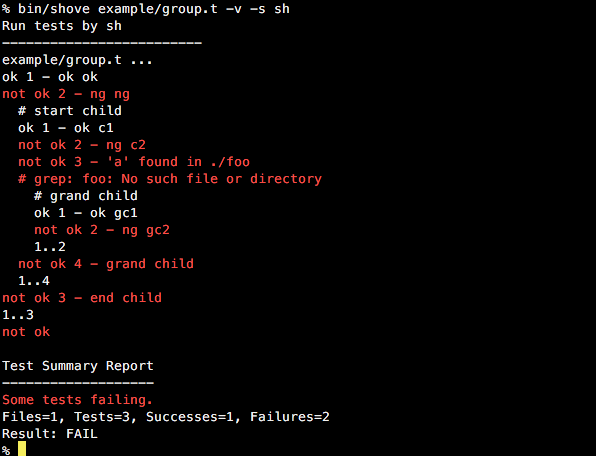A test tool for shell scripts with TAP outputs.
The name "shove" comes from "shell" and "prove" of Perl.
Pass:
Fail:
- sh, bash, dash, ksh, zsh
ash is not tested, but hopefully supposed to work with shove.
No plan to support (t)csh or fish because they are not POSIX compatible.
Just clone this repository or get tarballs from releases page.
# example snippet to install `shove`
mkdir ~/src
git clone https://github.com/progrhyme/shove.git ~/src/shove
alias shove="$HOME/src/shove/bin/shove"
shove -V
You can make a symlink of bin/shove in your favorite path;
i.e. /usr/local/bin/ or $HOME/bin/ or any path.
Or you can make an alias command like the snippet above.
NOTE:
Do not change the directory structure because bin/shove assumes
its libraries exists in ../lib/ directory.
shove TARGETS [OPTIONS]
shove t/foo.t
shove t/foo.t t/bar.t -s /bin/bash -v
shove -r t/ -v
# help
shove -h|--help
# version
shove -V|--version-s|--shell SHELL: SHELL to execute tests. Default is$SHELL.-v|--verbose: verbose output.-r|--recursive DIRECTORY: Search test script files with extension.tunder the directory
Many test functions get hints from Test::More of Perl.
There are some example test codes in example directory.
t_diag "Test for your shell scripts" # Log message visible on the test
t_pass # Always Pass
t_fail # Always Fail
t_ok $exp "exp is true" # [ $exp ]
t_ng $exp "exp is false" # [ ! $exp ]
t_present $str "str is present" # [ -n "$str" ]
t_blank $str "str is blank" # [ -z "$str" ]
t_exist $path "path exists" # [ -e "$path" ]
t_file $path "path is file" # [ -f "$path" ]
t_directory $path "path is directory" # [ -d "$path" ]
t_symlink $path "path is symlink" # [ -L "$path" ]
t_is $a $b "a is b" # [ "$a" = "$b" ]
t_isnt $a $b "a isn't b" # [ "$a" != "$b" ]
t_eq $x $y "x == y" # [ $x -eq $y ]
t_ne $x $y "x != y" # [ $x -ne $y ]
t_gt $x $y "x > y" # [ $x -gt $y ]
t_ge $x $y "x >= y" # [ $x -ge $y ]
t_lt $x $y "x < y" # [ $x -lt $y ]
t_le $x $y "x <= y" # [ $x -le $y ]
t_success $cmd "cmd succeeds" # $cmd; [ $? -eq 0 ]
t_error $cmd "cmd fails" # $cmd; [ $? -ne 0 ]This feature works like subtest of
Test::More.
New special syntax is introduced in v0.8.1:
t_ok $ok
t::group "level1 group" ({
t_diag "Comment for level1 tests"
t_ok $lv1_ok
t::group "level2 group" ({
t_diag "Comment for level2 tests"
t_ok $lv2_ok
t_is $lv2_a $lv2_b
})
})These codes are the same as following codes:
t_ok $ok
(
t_substart "level1 group"
t_diag "Comment for level1 tests"
t_ok $lv1_ok
(
t_substart "level2 group"
t_diag "Comment for level2 tests"
t_ok $lv2_ok
t_is $lv2_a $lv2_b
t_subclose
)
t_subend "level2 group"
t_subclose
)
t_subend "level1 group"Tests in group are run in subshell. So you can run them in different context from main tests context.
If you want test groups A and B not affect to each other, you have to put them in different groups.
CAUTION:
- The old grouping syntax
T_SUB (( ... ))will be unsupported in the future release.
IKEDA Kiyoshi progrhyme@gmail.com
The MIT License (MIT)
Copyright (c) 2016-2020 IKEDA Kiyoshi

